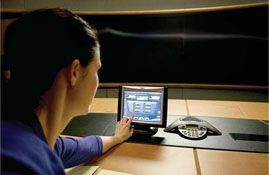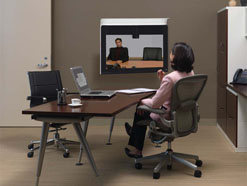Performance, Reliability, And Interoperability Have All Revived Our Perception Of VideoconferencingThere can be little doubt that, in its infancy, videoconferencing acquired itself something of a bad name. Poor quality images that broke up, stuttering or out of sync sound and regular interruptions of service were fairly routine. In the past few years, however, a number of technologies have come together to deliver a substantially improved user experience. Perhaps in an attempt to dispel those memories that nothing could have been less like being in the same room than the early proponents of the technology once
For manufacturers and resellers alike, today’s challenge is to integrate high-end videoconferencing solutions with remote end points that may in a hotel or home office. claimed, videoconferencing has, in effect, reinvented itself.
The new videoconferencing is ‘telepresence’. Those new technologies have enabled telepresence to become— well, virtually a reality. And even if telepresence is more than many end users want, those same technologies are combining to make ‘plain vanilla’ videoconferencing more reliable, more flexible, and more affordable.
Some of these technologies are much more visible than others. Take high definition screens, on the one hand, and codecs on the other, for example. They are opposite ends of the visibility spectrum, yet each is equally essential to the new conferencing experience.
Fumihiko Kawamura, Sony’s Product Marketing Manager for IPELA visual communication systems, is clear about the role of the latter in enabling delivery of the former. “If we can create better compression technology, we can deliver more information with the same bandwidth,” he says, citing Sony’s PCS-XG80 personal HD resolution videoconferencing unit as an example of the capabilities of superior codec technology.
THE CODEC IS KEY
Discussion of codecs, as Kawamura indicates, gives rise to discussion about the role of codecs in ensuring ‘QoS’— Quality of Service. QoS is about guarantees of bandwidth availability, about prioritization—and it’s a vital consideration where demand for network bandwidth exceeds availability. As the videoconferencing world moves to HD, with its significantly higher data load, improved codecs will allow bandwidth to be more effectively used. As LifeSize’s Ray Kenny points out: “Our company’s technology enables HD video to be delivered at only 1 Mbit/second of bandwidth, while DVD quality can be achieved with half that bandwidth—allowing users to avoid changes to the network or the expense of upgrading capacity.”
Equally invisible is the underlying silicon that enables, for example, codecs to perform faster—a point made by Barry Cross, Managing Director of videoconferencing technology distributor Touchline Video. “Technologically speaking, the advances in video hardware in terms of chip speed have led to the increased capability to process more demanding algorithms in terms of both video and audio,” he says. “The result is a user experience that is now better than ever before.”
Dan Somers, Managing Director of collaboration service provider vcnet, adds: “All the headlines talk about is HD and telepresence—but the really exciting stuff that enables them to happen is taking place behind the scenes. They’re enabling unified communications, where video is naturally integrated with the PBX, the desktop and the network, to become a reality.”

out of the boardroom.
“We have pioneered the adoption of the network as a simple-to-use and ubiquitous platform for video,” notes Marcus Gallo of Cisco. “This has brought about a new era of engagement and communication using video. The workplace video phenomenon is no longer restricted to senior managers; facilities and tools are being made available to employees at all levels, allowing them to produce, publish, share video content, have videoconferencing from their desks and virtual in-person meetings using the latest telepresence technology.”
NO SYSTEM IS AN ISLAND
And just as proprietary computing architectures have followed the dinosaur to extinction, so too with conferencing systems architectures. “The market for videoconferencing will continue to strengthen as the number of interoperable video system applications grows,” says Peter Nutley, Director of Global Product Marketing at Tandberg. “We are committed to providing standards compliant solutions to ensure that there are no ‘islands of communication.’”
The need for interoperability is, inevitably, leading to increasing collaboration between vendors: Nutley points out that his company is working with Microsoft to develop an HD webcam, and with Barco on a telecollaboration solution.
“More and more meetings are taking place utilizing tools a user can run from his or her desktop,” notes Mark Child, Director of Product Marketing for Telephony Products at ClearOne. “And as companies are moving to VoIP telephony systems, more of those meetings are taking place on the internet rather than over standard PSTN phone lines.”
As with virtually every other area of audiovisual technology, IP is assuming greater significance in conferencing. “In fact,” continues Child, “the likelihood is that many conference participants won’t even be at their desk-they’ll be at home, in an airport, or in a hotel room. Conferencing is changing not only to become more personal, but also more mobile. For us as a provider of audio conferencing solutions, each of these environments presents its own unique challenges relating to the phone connection quality, the room acoustics, ambient room noise and so on. Each environment requires the right advanced technology to produce the best possible experience for all.”

After years of operating in relative isolation, videoconferencing systems now integrate better with other AV technologies such as room control platforms. and of telepresence, it’s easy to forget that not all potential end users can hope to achieve this state of conferencing nirvana in the near future. Aethra’s CEO Marco Viezzoli sounds an appropriately cautionary note.
“The concept of telepresence still has a limited market due to the huge costs involved,” Viezzoli says. “High definition, on the other hand, is certainly increasing its share in markets with adequate bandwidth requirements. Let’s not forget, though, that the countries which are currently showing the most significant growth rates in terms of videoconferencing uptake are still focused on standard definition, mainly because of connectivity and cost constraints. We believe that what is particularly exciting at present is the possibility of integrating mixed networks-for example, professional endpoints and PCs-to achieve highly flexible, dynamic and accessible professional videoconferencing.”
Mark Child agrees. “There is a lot of buzz right now surrounding telepresence and its ability to provide a truly “immersive” conferencing experience,” he says. “The technology is quite exciting but the cost is out of reach for all but the largest enterprises.” LifeSize’s Ray Kenny might disagree, however, pointing to his company’s ‘Express’ telepresence product with a price below US$5,000.
And despite Viezzoli’s wise words, there can be little doubt that what the industry mostly wants to talk about right now is telepresence. As a term, it has gained an almost magical significance with its goal of making conference participants feel as if they are all in the same room. So it’s important to remember that telepresence is, in fact, little more than the coming together of a number of technologies. HD video, high-quality audio and the networks capable of supporting them are designed to make faces and voices more lifelike, capturing the subtleties and nuances in communication that are taken for granted when people are together in the same location.
THE MEETING YOU CAN’T MISS
Significantly, and regardless of how affordable or practicable it is, telepresence is capturing the attention of end users, and doing much to reposition the general perception of videoconferencing. It is, in effect, pulling new customers into the market, even if what those customers ultimately buy is not a telepresence solution.
Ray McGroarty, Solutions Marketing Director at Polycom EMEA, summarizes what he believes those customers are finding. “New technologies have changed the face of conferencing by offering flexibility, high quality, and total integration,” he says. “Nowadays people can attend the meeting by whichever method they have available at the time, whether it is just their mobile phone, or their telepresence suite. You don’t have to have video to attend the videoconference. We can now mix different classes of users into the same meeting. And even if you miss the meeting, we can record it so that it’s viewable later.
“The quality of experience for users is now so much higher, with CD stereo quality for voice, and HDTV quality for video, and really easy ways of getting your PC content into the meeting. And, we have great integration with the desktop and with PC applications, so that starting your videoconferencing can be as easy as making a phone call or sending an instant message.”
If success for an industry is a function of delivering what customers want, then the videoconferencing business seems set to continue on its exciting upward trajectory.










